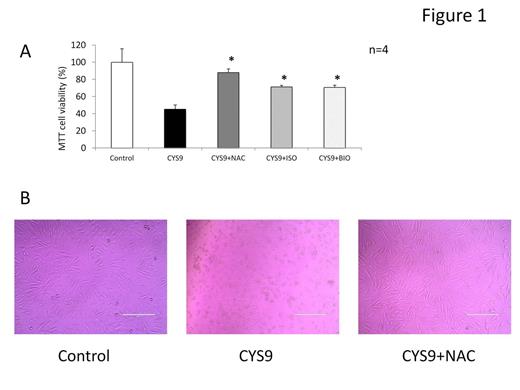Abstract
Background: High-dose Cyclophosphamide (CY) is a mainstay in most conditioning regimens for hematopoietic stem cell transplantation. Recently, high-dose, posttransplantation CY, a novel effective strategy for preventing graft-versus-host disease, has been attracting a lot of attention. CY is activated by the hepatic cytochrome P-450 (CYP) enzyme system to form 4-hydroxy-cyclophosphamide (HCY), which is in equilibrium with aldocyclophosphamide (AldoCY). Depending on the type of the cell, AldoCY decomposes to form cytotoxic phosphoramide mustard and the byproduct acrolein. Alternatively, aldoCY is oxidized to the inactive metabolite o-carboxyethylphosphoramide mustard (CEPM) by aldehyde dehydrogenase1 (ALDH1). The dose-limiting toxic effect of CY, observed only after administration of high-doses, is cardiotoxicity. Since the mechanism underlying this phenomenon has not yet been elucidated, we investigated the cardiotoxic mechanisms of high-dose CY. To determine preliminary mechanisms that may prevent the occurrence of CY-induced cytotoxicity in H9C2 cells, we also evaluated the protective effects of potential cardioprotectant agents (PCA).
Methods: A rat cardiac myocardial cell line, H9C2, was exposed to CY metabolized by S9 fraction of rat liver homogenate mixed with co-factors (CYS9). The concentration of CY in this experiment was determined based on values measured in blood samples from patients receiving CY in high doses. The degree of cytotoxicity was then evaluated by MTT assay, LDH release, production of reactive oxygen species (ROS), and incidence of apoptosis. We also investigated how the myocardial cellular effects of CYS9 were modified by acrolein scavenger N-acetylcysteine (NAC), antioxidant isorhamnetin (ISO), and ƒÀ-ionone (BIO) a CYP inhibitor. Quantifying CY and CY metabolites, using liquid chromatography coupled with electrospray tandem mass spectrometry (LC/MS/MS), we assayed culture supernatants of CYS9 with or without PCA and also tested with HCY, CEPM and acrolein. In addition, we observed the cytotoxicity of CYS9 and the protective effects of PCA using a live-cell imaging system. Finally, using leukemia cell lines, we confirmed whether each of the above PCAs inhibits the antileukemic effects of CYS9.
Results: The peak average concentration of CY in three patients receiving high-dose CY therapy was 257 ± 46 ƒÊM. After 250 ƒÊM of CY was metabolized in S9 mix for 2 h, the concentration of HCY was 17.6 ± 4.3, CEPM 26.6 ± 5.3 ƒÊM, and acrolein 30.8 ± 1.3 ƒÊM. Assay results for MTT and LDH release showed that treatment with CY (500 ƒÊM) did not cause cytotoxicity. However, CYS9 (CY 250 ƒÊM) exhibited myocardial cytotoxicity. NAC, ISO, and BIO all inhibited CYS9-induced cytotoxicity (Fig.1). When treated with ISO or BIO, metabolism of CY was significantly inhibited. Pre-treatment with NAC, however, did not inhibit the metabolism of CY. Compared to control samples, we observed no difference in HCY, a significant increase of CEPM, and a significant decrease of acrolein (Fig.2). Furthermore, NAC pre-treatment did not affect intracellular ROS levels produced by CYS9. Live-cell imaging also confirmed that CYS9 induced acute cytotoxicity, which was inhibited by NAC. Finally, NAC did not inhibit the CYS9-induced antileukemic effect.
Discussion: According to results from LC/MS/MS, we ascertained that, when metabolized in vitro by S9, CY would produce similar levels of metabolic substance concentrations as in vivo. When H9C2 was pre-treated with NAC, ISO, and BIO, each inhibited cell damage by CYS9. When treated with ISO and BIO, we observed that CY metabolism itself was inhibited. This result suggests that cardiac cell damage may depend on individual differences in CY metabolic capacity. As preventative drugs, however, both BIO and ISO seem likely to interfere with antitumor effects and are thought to be unsuitable.NAC pre-treatment did not inhibit CY metabolism: compared to control samples, there was no difference in HCY concentration, but there was a significant increase in CEPM concentration. Less acrolein, however, was present after exposure to NAC. The increase in CEPM suggests that scavenging of acrolein by NAC prevents inhibition of ALDH1; in the absence of acrolein, AldoCY is metabolized to CEPM. NAC attenuates high-dose CY induced cardiotoxicity through a mechanism related to its ability to decrease of acrolein.
No relevant conflicts of interest to declare.
Author notes
Asterisk with author names denotes non-ASH members.



This feature is available to Subscribers Only
Sign In or Create an Account Close Modal